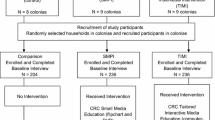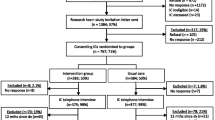Abstract
Anal cancer incidence is higher in persons living with HIV/AIDS (PLWHA) than in the general population. Participation of PLWHA in anal cancer clinical trials (CTs) is essential; Hispanic PLWHA are underrepresented in CTs. We conducted a behavioral CT among 305 PLWHA in Puerto Rico to measure the efficacy of an educational video in increasing calls and screening into an anal cancer CT. Participants received printed educational materials on anal cancer and CTs; the intervention group also received an educational video. Outcome assessment based on follow-up interviews showed that printed materials increased awareness about CTs and high-resolution anoscopy (HRA), and willingness to participate in an anal cancer CT in both groups. However, the addition of the video increased the likelihood of participants to call the CT for orientation (RRadjusted = 1.66, 95% CI 1.00–2.76; p = 0.05) and pre-screening evaluation (RRadjusted = 1.70, 95% CI 0.95–3.03; p = 0.07). This intervention could help increase participation of Hispanics into anal cancer-related CTs.
Resumen
El cáncer anal es más común en personas con VIH/SIDA que en la población general. La participación de estas personas en ensayos clínicos (ECs) es esencial; los hispanos están sub-representados en los ECs. Realizamos un EC en 305 personas con VIH/SIDA en Puerto Rico, para medir la eficacia de un video educativo en aumentar las llamadas y el cernimiento a un EC de cáncer anal. Los participantes recibieron material impreso sobre cáncer anal y ECs; el grupo de intervención también observό el video educativo. Los resultados mostraron que los materiales impresos aumentaron la concienciación sobre ECs y la anoscopía, y la disposición de participar en un EC de cáncer anal. Sin embargo, el video educativo aumentό la posibilidad de que los participantes llamaran para orientación (RRajustado = 1.66, 95% CI 1.00–2.76; p = 0.05) y evaluación (RRajustado = 1.70, 95% CI 0.95–3.03; p = 0.07) para un ECs de cáncer anal. Esta intervención puede ayudar a aumentar la participación de Hispanos en ECs de cáncer anal.


Similar content being viewed by others
References
Colón-López V, Shiels MS, Machin M, Ortiz AP, Strickler H, Castle PE, et al. Anal cancer risk among people with HIV infection in the United States. J Clin Oncol [Internet]. 2017 Nov 15 [cited 2017 Dec 20];JCO.2017.74.929. http://www.ncbi.nlm.nih.gov/pubmed/29140774.
Hillman RJ, Cuming T, Darragh T, Nathan M, Berry-Lawthorn M, Goldstone S, et al. 2016 IANS international guidelines for practice standards in the detection of anal cancer precursors. J Low Genit Tract Dis [Internet]. 2016;20(4):283–91. http://www.ncbi.nlm.nih.gov/pubmed/27561134.
Denicoff AM, McCaskill-Stevens W, Grubbs SS, Bruinooge SS, Comis RL, Devine P, et al. The National Cancer Institute-American Society of Clinical Oncology Cancer Trial Accrual Symposium: summary and recommendations. J Oncol Pract [Internet]. 2013;9(6):267–76. http://www.ncbi.nlm.nih.gov/pubmed/24130252.
King TE. Racial disparities in clinical trials. N Engl J Med [Internet]. 2002;346(18):1400–2. http://www.nejm.org/doi/abs/10.1056/NEJM200205023461812.
Murthy VH, Krumholz HM, Gross CP. Participation in cancer clinical trials. JAMA [Internet]. 2004;291(22):2720. http://www.ncbi.nlm.nih.gov/pubmed/15187053.
Byrne MM, Tannenbaum SL, Glück S, Hurley J, Antoni M. Participation in cancer clinical trials. Med Decis Mak [Internet]. 2014;34(1):116–26. http://journals.sagepub.com/doi/10.1177/0272989X13497264.
Bernard-Davila B, Aycinena AC, Richardson J, Gaffney AO, Koch P, Contento I, et al. Barriers and facilitators to recruitment to a culturally-based dietary intervention among urban Hispanic breast cancer survivors. J racial Ethn Heal disparities [Internet]. 2015;2(2):244–55. http://www.ncbi.nlm.nih.gov/pubmed/26557471.
Heumann C, Cohn SE, Krishnan S, Castillo-Mancilla JR, Cespedes M, Floris-Moore M, et al. Regional variation in HIV clinical trials participation in the United States. South Med J [Internet]. 2015;108(2):107–16. http://www.ncbi.nlm.nih.gov/pubmed/25688896.
Stacey D, Légaré F, Lewis K, Barry MJ, Bennett CL, Eden KB, et al. Decision aids for people facing health treatment or screening decisions. Cochrane Database of Syst Rev. 2017. https://doi.org/10.1002/14651858.CD001431.
Abu Abed M, Himmel W, Vormfelde S, Koschack J. Video-assisted patient education to modify behavior: a systematic review. Patient Educ Couns. 2014;97(1):16–22.
Banda DR, Mete M, Swain SM. A clinical trial with culturally appropriate video to increase participation of African Americans in cancer clinical trials. J Clin Oncol [Internet]. 2011;29(27_suppl):159–159. https://doi.org/10.1200/jco.2011.29.27_suppl.159.
Hutchison C, Cowan C, McMahon T, Paul J. A randomised controlled study of an audiovisual patient information intervention on informed consent and recruitment to cancer clinical trials. Br J Cancer [Internet]. 2007;97(6):705–11. http://www.ncbi.nlm.nih.gov/pubmed/17848908.
Tuong W, Larsen ER, Armstrong AW. Videos to influence: a systematic review of effectiveness of video-based education in modifying health behaviors. J Behav Med [Internet]. 2014;37(2):218–33. http://www.ncbi.nlm.nih.gov/pubmed/23188480.
Calderon Y, Cowan E, Nickerson J, Mathew S, Fettig J, Rosenberg M, et al. Educational effectiveness of an HIV pretest video for adolescents: a randomized controlled trial. Pediatrics. 2011;127(5):911–6.
Hall EW, Sanchez TH, Stein AD, Stephenson R, Zlotorzynska M, Sineath RC, et al. Use of videos improves informed consent comprehension in web-based surveys among internet-using men who have sex with men: a randomized controlled trial. J Med Internet Res. 2017;19(3):e64.
Obeid JS, McGraw CA, Minor BL, Conde JG, Pawluk R, Lin M, et al. Procurement of shared data instruments for research electronic data capture (REDCap). J Biomed Inform. 2013;46(2):259–65.
Cook DA, Artino AR. Motivation to learn: an overview of contemporary theories the cross-cutting edge. Med Educ Med Educ Educ [Internet]. 2016;50(50):997–1014. www.mededuc.com.
Flaskerud JH. CULTURAL COMPETENCE: WHAT IS IT? Issues Ment Health Nurs [Internet]. 2007;28(1):121–3. http://www.tandfonline.com/doi/full/10.1080/01612840600998154.
Du W, Mood D, Gadgeel S, Simon MS. An educational video to increase clinical trials enrollment among lung cancer patients. J Thorac Oncol [Internet]. 2008;3(1):23–9. http://linkinghub.elsevier.com/retrieve/pii/S1556086415311989.
Du W, Mood D, Gadgeel S, Simon MS. An educational video to increase clinical trials enrollment among breast cancer patients. Breast Cancer Res Treat [Internet]. 2009;117(2):339–47. http://www.ncbi.nlm.nih.gov/pubmed/19152024.
Cartmell KB, Bonilha HS, Matson T, Bryant DC, Zapka JG, Bentz TA, et al. Patient participation in cancer clinical trials: a pilot test of lay navigation. Contemp Clin trials Commun [Internet]. 2016;3:86–93. http://www.ncbi.nlm.nih.gov/pubmed/27822566.
Ford JG, Howerton MW, Lai GY, Gary TL, Bolen S, Gibbons MC, et al. Barriers to recruiting underrepresented populations to cancer clinical trials: a systematic review. Cancer [Internet]. 2008;112(2):228–42. http://www.ncbi.nlm.nih.gov/pubmed/18008363.
Castillo-Mancilla JR, Cohn SE, Krishnan S, Cespedes M, Floris-Moore M, Schulte G, et al. Minorities remain underrepresented in HIV/AIDS research despite access to clinical trials. HIV Clin Trials [Internet]. 2014;15(1):14–26. http://www.ncbi.nlm.nih.gov/pubmed/24518211.
Brooks RA, Newman PA, Duan N, Ortiz DJ. HIV vaccine trial preparedness among Spanish-speaking Latinos in the US. AIDS Care [Internet]. 2007;19(1):52–8. http://www.ncbi.nlm.nih.gov/pubmed/17129857.
Geller MA, Downs LS, Judson PL, Ghebre R, Argenta PA, Carson LF, et al. Learning about ovarian cancer at the time of diagnosis: video versus usual care. Gynecol Oncol [Internet]. 2010;119(2):370–5. http://linkinghub.elsevier.com/retrieve/pii/S0090825810005202.
Sood A, Prasad K, Chhatwani L, Shinozaki E, Cha SS, Loehrer LL, et al. Patients’ attitudes and preferences about participation and recruitment strategies in clinical trials. Mayo Clin Proc [Internet]. 2009;84(3):243–7. http://www.ncbi.nlm.nih.gov/pubmed/19252111.
Gwadz M, Cleland CM, Belkin M, Ritchie A, Leonard N, Riedel M, et al. ACT2 peer-driven intervention increases enrollment into HIV/AIDS medical studies among African Americans/Blacks and Hispanics: A cluster randomized controlled trial. AIDS Behav [Internet]. 2014;18(12):2409–22. http://www.ncbi.nlm.nih.gov/pubmed/24961193.
Sully BGO, Julious SA, Nicholl J. A reinvestigation of recruitment to randomised, controlled, multicenter trials: a review of trials funded by two UK funding agencies. Trials [Internet]. 2013;14:166. http://www.ncbi.nlm.nih.gov/pubmed/23758961.
Acknowledgements
We want to thank Dr. Joel Palefsky from the University of California, San Francisco, for his suggestions to this manuscript. We also want acknowledge the support of the ANCHOR trial, and of Dr. Maribel Tirado, Cristina Muñoz and Diana Medina, members of ANCHOR's Puerto Rico site, in the execution of this study.
Funding
This study was funded by the UPRCC/MDACC Partnership for Excellence in Cancer Research (Award Number U54 CA096297/CA096300); and partially supported by the University of California Davis Comprehensive Cancer Center (Award Number U54 CA153499/CA093373) and the ANCHOR study (Award Number U01 CA121947), through funding of the National Cancer Institute, and by the Puerto Rico Clinical and Translational Research Consortium (Award Number U54MD007587), through funding of the National Institute of Minority Health and Health Disparities, of the National Institutes of Health.
Author information
Authors and Affiliations
Corresponding author
Ethics declarations
Conflict of Interest
All authors declare that they have no conflict of interest.
Ethical Approval
All procedures performed in studies involving human participants were in accordance with the ethical standards of the institutional and/or national research committee and with the 1964 Helsinki declaration and its later amendments or comparable ethical standards.
Informed Consent
Informed consent was obtained from all individual participants included in the study.
Rights and permissions
About this article
Cite this article
Ortiz, A.P., Machin, M., Soto-Salgado, M. et al. Effect of an Educational Video to Increase Calls and Screening into an Anal Cancer Clinical Trial Among HIV+ Hispanics in PR: Results from a Randomized Controlled Behavioral Trial. AIDS Behav 23, 1135–1146 (2019). https://doi.org/10.1007/s10461-018-2330-z
Published:
Issue Date:
DOI: https://doi.org/10.1007/s10461-018-2330-z




